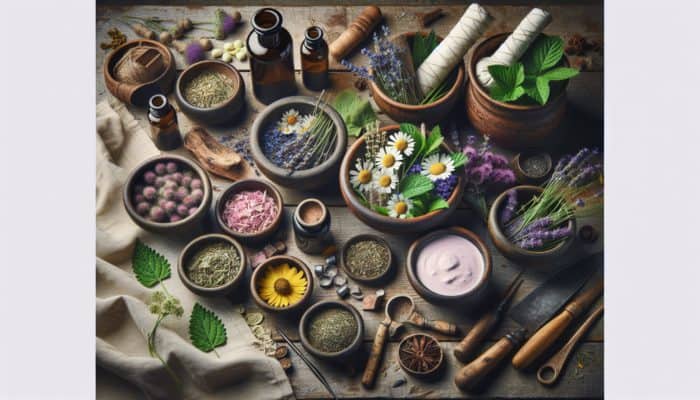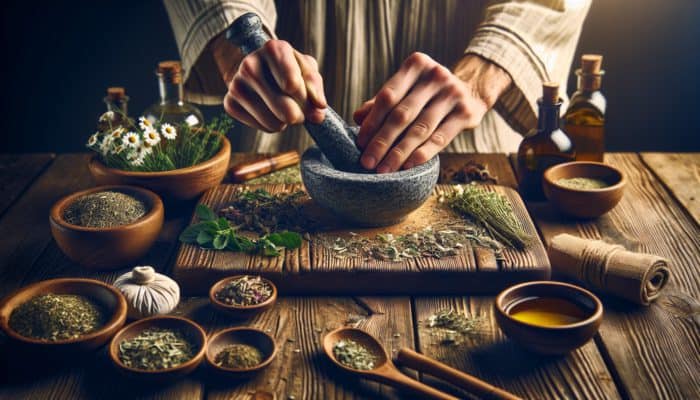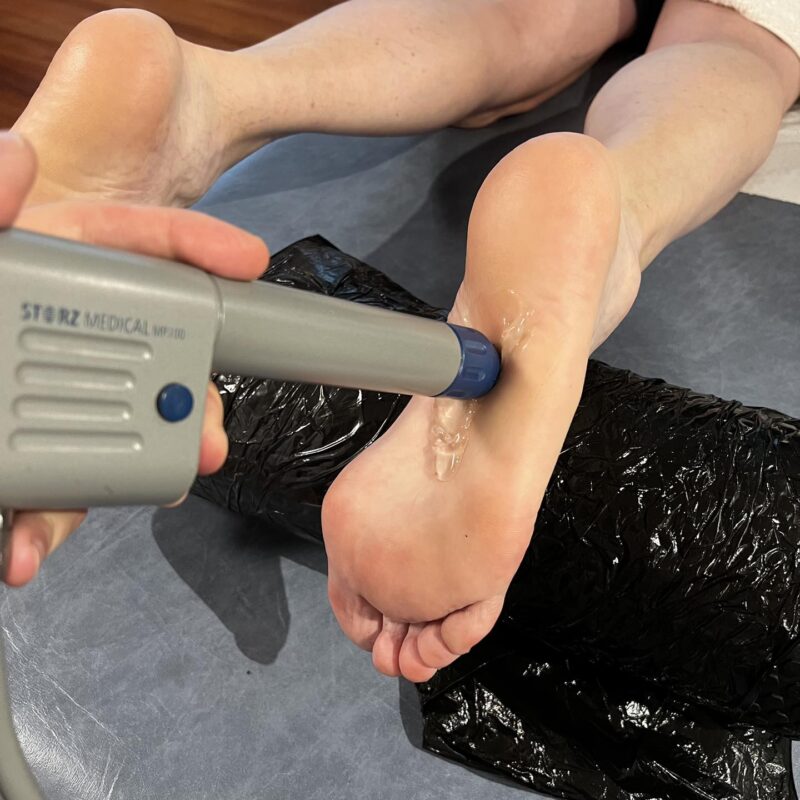Discover the Healing Power of Herbal Poultices in the UK
What Exactly Are Herbal Poultices?

How to Prepare Herbal Poultices: Herbal poultices represent a unique form of moist herbal packs that are applied directly onto the skin to utilise the therapeutic properties of the herbs contained within. They boast a rich history, having been employed for centuries by various cultures for their remarkable healing benefits. The ease of preparation makes these remedies accessible to everyone, and their effectiveness in alleviating discomfort while promoting the healing process is well-established in various studies. A poultice's true essence lies in its ability to draw out beneficial compounds from herbs, enabling these natural treatments to be absorbed through the skin and providing targeted relief and healing in the affected areas.
To prepare herbal poultices, one typically combines fresh or dried herbs that are moistened with water, oil, or another suitable liquid to create a paste-like consistency. This paste is then applied directly to the affected area and covered with a cloth or gauze to keep it in place securely. The moisture facilitates the extraction of the active components of the herbs, while the warmth enhances circulation to the area, further supporting the healing process. In the contemporary UK setting, a resurgence in natural remedies aligns with a growing movement towards sustainable and holistic health practices, underscoring the relevance of herbal poultices in modern wellness.
What is the Historical Context of Herbal Remedies in the UK?
The tradition of using herbal remedies in the UK dates back to ancient times, when diverse cultures relied heavily on nature for their healing needs. Historical accounts reveal that the Celts and Anglo-Saxons possessed profound knowledge of local flora and actively incorporated herbs such as Yarrow and elderflower into their medicinal practices. This tradition of herbal usage has been preserved through the ages, with many recipes and remedies being handed down through generations, often woven into the fabric of family folklore and cultural heritage.
The writings of distinguished herbalists significantly shaped the formal establishment of herbal medicine within the UK. For instance, Nicholas Culpeper, a 17th-century herbalist, meticulously documented the uses and medicinal properties of various plants in his influential work, “The English Physician.” This invaluable reference not only highlights the historical significance of herbs but also underscores the continuing relevance of herbal poultices in today's health practices. Gaining an understanding of this rich heritage fosters a greater appreciation for herbal poultices, emphasising the necessity of preserving traditional knowledge amidst an increasingly modern world.
What Are the Key Benefits of Using Herbal Poultices?
Herbal poultices offer numerous benefits, making them a vital addition to any natural health regimen. They are widely acknowledged for their ability to reduce inflammation, alleviate pain, and expedite the healing process for a variety of health issues. A significant advantage of opting for herbal poultices is their natural formulation, which often translates to fewer side effects compared to conventional medications. This aspect is particularly appealing to individuals keen on minimising their reliance on pharmaceuticals in favour of more natural alternatives.
Moreover, herbal poultices can be customised to address specific health concerns, allowing for a tailored approach to treatment. For example, using locally sourced herbs not only promotes sustainable practices but also fosters a deeper connection to one’s environment. The application of poultices aligns well with the growing interest in holistic health and wellness, providing a straightforward yet effective way to manage discomfort naturally. Engaging with these herbal remedies also fosters a deeper understanding of the natural world and the numerous benefits it can offer for our health.
Which Herbs Are Commonly Used in UK Herbal Poultices?

Selecting the right herbs is vital for the efficacy of herbal poultices. In the UK, several herbs are frequently utilised due to their availability and well-documented healing properties. Comfrey, chamomile, and lavender are among the most popular choices for herbal enthusiasts and practitioners alike. These herbs are not only widely accessible but are also renowned for their potent therapeutic effects.
- Comfrey: Renowned for its remarkable ability to promote healing in wounds and fractures.
- Chamomile: Valued for its soothing properties, especially in alleviating skin irritations.
- Lavender: Well-known for its calming effects, making it useful for reducing stress and anxiety.
- Plantain: Effective for treating insect bites and skin irritations due to its anti-inflammatory qualities.
- Yarrow: Known for its ability to stop bleeding and reduce inflammation.
- Marshmallow Root: Helpful for soothing irritated skin and mucous membranes.
These herbs can be easily sourced from local gardens, health food stores, or even foraged from the wild, depending on the season. Understanding the properties of these herbs allows practitioners to effectively tailor their poultices to address the specific ailments they intend to treat.
Expert Insights on Mastering the Art of Herbal Poultice Preparation
How to Select the Right Herbs for Your Herbal Poultice
Selecting the right herbs for a poultice is crucial to achieving the desired therapeutic effects. The selection process should be guided by the specific ailment being addressed, as well as the inherent properties of the herbs themselves. For instance, if the aim is to reduce inflammation, herbs such as comfrey and Yarrow are optimal choices due to their established anti-inflammatory qualities. Conversely, if the focus is on soothing minor skin irritations or enhancing relaxation, chamomile or lavender might be more suitable options.
When selecting herbs for your poultice, consider the following key herbs and their corresponding uses:
- Comfrey: Effective for treating sprains and promoting wound healing.
- Plantain: Ideal for insect bites, stings, and minor cuts.
- Yarrow: Beneficial for reducing swelling and pain associated with injuries.
- Chamomile: Excellent for calming irritation and promoting relaxation.
- Turmeric: Known for its anti-inflammatory properties, making it great for pain relief.
- Marshmallow Root: Useful for soothing irritated skin and respiratory issues.
In addition to their medicinal properties, consider the availability of these herbs in your local area. Many herbs can be sourced from gardens, local markets, or foraged from the wild, making them practical and accessible options for creating effective poultices.
What Are the Best Techniques for Preparing Herbal Poultices?

Preparing a herbal poultice involves several straightforward steps, although the method may vary slightly depending on the herbs used and the condition being treated. The initial step is to gather your selected herbs, which can be either fresh or dried. If you opt for dried herbs, a larger quantity may be required compared to fresh herbs, as the latter retains more moisture.
Once you have your herbs, the next step is to moisten them. You can achieve this by using warm water, herbal tea, or even oils such as olive or coconut oil, depending on the intended effect. For example, using warm chamomile tea can significantly enhance the soothing properties of a chamomile poultice. After moistening, crush or bruise the herbs to release their active components. A mortar and pestle is ideal for this, but you can also use the back of a spoon or your fingers to achieve the desired consistency.
After your herbs are prepared, apply them directly onto the affected area, ensuring an even layer is created. Cover the poultice with a cloth or gauze to keep it securely in place while maintaining warmth. It is crucial to ensure that the poultice is not excessively hot to avoid skin burns. Monitor the application for the required duration, which can vary depending on the specific herbs used and the ailment being treated.
How Long Should a Poultice Be Applied?
The duration for which a poultice should be applied can vary significantly based on the type of herb used and the specific condition being addressed. Generally, herbal poultices are left on the skin for a duration of 20 to 60 minutes. It is vital to monitor the skin's reaction throughout the application period. If the poultice feels excessively hot or causes irritation, it should be removed immediately.
In certain cases, particularly for chronic conditions, poultices can be reapplied several times a day. However, consulting a qualified herbalist or healthcare provider is advisable if the poultice is used for extended periods or if the skin exhibits any signs of irritation. Always pay attention to how your body responds to the poultice; individual reactions can vary based on skin sensitivity and the specific herbs employed.
Regularly assess the effectiveness of the poultice and make adjustments as necessary, whether by altering the herbs used or modifying the application duration. This personalised approach ensures optimal benefits from herbal poultices while safeguarding skin health.
Exploring Common Herbs for Herbal Poultices in the UK
Experience the Healing Benefits of Comfrey
Comfrey is an extraordinary herb celebrated for its powerful healing properties. Its leaves contain allantoin, a compound that stimulates cell regeneration and encourages healing, making it particularly effective for treating wounds, sprains, and bruises. In the UK, comfrey is readily found in gardens and is often regarded as a staple in herbal remedies.
To prepare a comfrey poultice, begin by gathering fresh comfrey leaves. Crush them to release their natural juices, then apply the resulting paste directly onto the affected area. Cover the poultice with a cloth to hold it in position. This poultice can be left on for 30 to 60 minutes; the healing qualities of comfrey can significantly reduce inflammation and accelerate recovery from injuries.
However, it is essential to exercise caution when applying comfrey poultices to broken skin, as it contains certain alkaloids that may pose risks if absorbed in large quantities. Always consult with a professional before using comfrey on open wounds. Despite this precaution, comfrey remains a highly esteemed herb in the UK for its effectiveness in promoting healing and alleviating pain.
Discover the Versatility of Plantain
Plantain is a highly versatile herb commonly found in UK gardens and fields, often regarded as a natural remedy for first aid. Its leaves are recognised for their anti-inflammatory and antimicrobial properties, making it an excellent choice for treating insect bites, stings, and minor cuts. The ability of plantain to draw out toxins and promote healing makes it an essential addition to any herbalist's toolkit.
To create a plantain poultice, gather fresh leaves and rinse them thoroughly to eliminate any dirt or debris. Crush or bruise the leaves to release their beneficial juices. Apply the paste directly to the affected area, securing it with a cloth or bandage. The poultice can be left on for 20 to 30 minutes, providing soothing relief from itching and irritation.
What makes plantain particularly appealing is its abundance in the wild, allowing for easy foraging. Just ensure you correctly identify the plant before using it. This accessibility, combined with its effectiveness, makes plantain an invaluable herbal remedy for a variety of skin issues.
Yarrow: Harness the Anti-Inflammatory Properties
Yarrow is another potent herb celebrated for its anti-inflammatory properties, commonly found throughout the UK. This herb has been traditionally used to treat a wide range of ailments, including reducing swelling, alleviating pain, and promoting wound healing. Both the flowers and leaves of Yarrow are effective, containing active compounds that contribute to its therapeutic effects.
To prepare a yarrow poultice, gather fresh leaves and flowers, ensuring they are clean and free from contaminants. Crush the plant material to release its juices, and then apply it directly to the affected area. Cover the poultice with a cloth to secure it, leaving it in place for 20 to 60 minutes, depending on the severity of the condition being treated.
Yarrow poultices are particularly useful for addressing injuries, cuts, and bruises, as they enhance circulation and support the healing process. As with any herbal remedy, it is crucial to monitor for any adverse skin reactions. Yarrow exemplifies the healing potential of nature and remains a popular choice among herbalists in the UK.
Guidelines for Safe Application of Herbal Poultices
What Precautions Should You Take When Using Herbal Poultices?
When employing herbal poultices, prioritising safety is paramount. The first precaution is to ensure that all herbs are clean and free from pesticides or contaminants. This can be accomplished by sourcing herbs from reputable suppliers or cultivating them in a controlled environment. Always wash fresh herbs thoroughly before use to remove any dirt or chemical residues.
It is also essential to conduct a patch test before applying a poultice more broadly. Apply a small quantity of the prepared poultice to a discreet area of skin and observe for any allergic reactions, such as redness, swelling, or irritation. This step is particularly crucial for individuals with sensitive skin or known allergies.
Avoid using poultices on open wounds unless instructed by a qualified professional. Even when applied to intact skin, it is vital to monitor for adverse reactions during the application period. If any irritation occurs, remove the poultice immediately and cleanse the area with clean water. Being cautious and attentive can prevent complications and elevate the overall safety of using herbal poultices.
How to Prepare Your Skin for a Herbal Poultice
Before applying a poultice, preparing the skin is a critical step that enhances the overall effectiveness of the herbal remedy. Start by cleaning the area where the poultice will be placed to remove any dirt, oils, or previous products that may interfere with absorption. A gentle cleanser that does not irritate the skin is ideal, particularly for sensitive areas.
After cleansing, warming the skin slightly can also be beneficial, as this action enhances blood circulation and promotes better absorption of the herbal properties. A warm compress can be used for this purpose, applied for a few minutes before placing the poultice. This simple step can significantly enhance the efficacy of the herbs used.
Once the area is clean and warmed, apply the poultice as instructed. Ensuring that the poultice maintains contact with the skin will allow the beneficial compounds to penetrate more effectively, resulting in enhanced therapeutic effects. Following these preparatory steps can lead to a more successful application and a better overall experience with herbal poultices.
Monitoring and Aftercare for Herbal Poultices
After applying a herbal poultice, it is crucial to monitor the skin for any adverse reactions, ensuring both safety and effectiveness. Pay close attention to any signs of irritation, such as redness or burning sensations. If discomfort arises, promptly remove the poultice and cleanse the area with gentle soap and water.
Following the removal of the poultice, it is advisable to nourish the skin with a soothing cream or lotion. Natural products containing ingredients such as calendula, aloe vera, or chamomile can provide additional hydration and further support the healing process. These natural aftercare options can enhance the overall effectiveness of the poultice and promote skin health.
It's also essential to assess the overall effectiveness of the poultice. If positive results are observed, consider incorporating herbal poultices into your health routine for ongoing issues. However, if symptoms persist or worsen, consult a healthcare professional for further guidance. Monitoring the skin’s response and adjusting the approach as needed ensures the best possible outcomes from herbal poultices.
Choosing the Right Herbs for Your Herbal Poultices
Selecting the appropriate herbs for your poultice is vital for achieving the desired therapeutic effects. When choosing herbs, consider their medicinal properties and safety. For example, chamomile is renowned for its soothing properties, making it an ideal choice for calming irritated skin. In contrast, turmeric is renowned for its anti-inflammatory properties and is particularly effective in alleviating conditions associated with pain and swelling.
Always research the herbs you plan to use or consult with a qualified herbalist for guidance. This step is especially important if you are new to herbal remedies or uncertain about the properties of certain plants. Familiarising yourself with the characteristics and uses of various herbs empowers you to make informed decisions regarding your poultice preparations.
Selecting herbs based on their medicinal benefits ensures that your poultices effectively target specific ailments. When combined with proper preparation methods, the right herbs can provide significant relief and support the body’s natural healing processes. Engaging with herbal medicine in this manner fosters a deeper connection to nature and its healing potential.
Research-Backed Benefits of Herbal Poultices
How Do Herbal Poultices Effectively Reduce Inflammation?
Herbal poultices can effectively reduce inflammation, primarily by drawing out toxins and enhancing circulation to the affected area. The application of herbs such as comfrey and Yarrow has been documented to alleviate swelling and pain commonly associated with inflammation. The warm, moist environment created by the poultice encourages blood flow, which can significantly expedite the healing process.
Research has indicated that herbs like comfrey contain active compounds that exhibit anti-inflammatory effects. For instance, the application of comfrey poultices has been shown to enhance recovery times for injuries, showcasing their utility in managing both acute and chronic inflammatory conditions. Real-world examples highlight the effectiveness of poultices for conditions such as arthritis, where the localised application of anti-inflammatory herbs can provide substantial relief.
Furthermore, incorporating poultices as part of a holistic health approach can enhance overall well-being. Regular application for chronic conditions can lead to sustained improvements in inflammation, ultimately reducing reliance on pharmaceutical interventions while promoting natural healing processes.
What Conditions Can Be Effectively Treated with Herbal Poultices?
Herbal poultices serve as a versatile tool for treating a wide array of conditions, making them invaluable in natural health practices. Commonly, poultices are employed to address ailments such as sprains, bruises, minor infections, and skin irritations. Their effectiveness is particularly notable for conditions that benefit from the direct application of herbal properties onto the skin.
For example, poultices made from plantain are highly effective for treating insect bites and stings, alleviating discomfort and promoting healing. Similarly, yarrow poultices can be beneficial for reducing swelling and pain associated with injuries. The topical application enables the direct absorption of the herbs' medicinal compounds, resulting in quicker relief compared to oral remedies.
In addition to addressing acute injuries, herbal poultices can also be utilised for chronic conditions such as arthritis and muscle pain. Their anti-inflammatory properties make them suitable for long-term management of discomfort, providing a natural alternative to pharmaceutical treatments. The adaptability of herbal poultices underscores their value in the realm of holistic health practices.
Are There Any Side Effects Associated with Herbal Poultices?
While herbal poultices are generally safe for most individuals, it is essential to remain vigilant regarding potential side effects, particularly for those with sensitive skin or allergies. Some individuals may experience allergic reactions to specific herbs, resulting in redness, itching, or swelling upon application. Conducting a patch test before the full application can help identify any adverse reactions early on.
Moreover, using poultices on open wounds can pose challenges, as some herbs may cause irritation or introduce bacteria. Always consult a healthcare professional if you have any uncertainty about the safety of using specific herbs for certain conditions.
It is also advisable to avoid prolonged use of poultices without breaks, as repeated applications may lead to skin irritation. If any adverse reactions occur, discontinue use immediately and thoroughly clean the affected area. Awareness of these potential side effects facilitates safer and more effective use of herbal poultices, ensuring a positive experience in the realm of natural healing.
Reliable Strategies for Preparing Herbal Poultices
How Can You Properly Store Herbal Poultices?
Proper storage of herbal poultices is crucial for maintaining their efficacy and preventing spoilage. For short-term use, herbal poultices can be refrigerated, ideally in an airtight container to protect them from moisture and external contaminants. When stored correctly, they can remain effective for several days.
For longer storage, it is advisable to dry the herbs used in the poultice before preparation. Dried herbs can be stored in airtight containers in a cool, dark place, which helps preserve their potency. Always label and date your containers to keep track of freshness and usability.
When preparing poultices, consider making small batches to minimise wastage, as the active properties of herbs can degrade over time. Reusing poultices is generally not recommended, as they can lose effectiveness and potentially harbour bacteria. By following these storage guidelines, you can ensure that your herbal poultices remain safe and effective when needed.
What Essential Tools Are Needed for Making Herbal Poultices?
Creating effective herbal poultices can be streamlined with the right tools and techniques. Basic tools for making poultices include the following:
- Mortar and Pestle: Ideal for crushing and bruising herbs to release their natural juices.
- Bowl: Useful for mixing herbs with liquids to create a tincture.
- Cloth or Gauze: Essential for wrapping the poultice and securing it in place on the skin.
- Measuring cups are helpful for accurately measuring liquids or dried herbs.
- Scissors: Useful for cutting cloth to the desired size for poultice application.
Having these essential tools on hand not only simplifies the preparation process but also ensures a more effective outcome. Using a mortar and pestle allows for thorough crushing of herbs, which is key to releasing their therapeutic compounds. Preparation becomes more straightforward and enjoyable when equipped with the right kitchen essentials.
Is It Possible to Reuse Herbal Poultices?
Generally, reusing herbal poultices is not advisable due to the potential for reduced effectiveness and the risk of bacterial growth. Once a poultice has been applied, the active compounds may be depleted, diminishing its therapeutic benefits for subsequent applications. Additionally, the moisture from the poultice can create an environment conducive to bacterial growth, potentially leading to skin issues.
If there is a compelling reason to reuse a poultice, ensure it is thoroughly cleaned and dried beforehand. However, it is typically more advantageous to prepare a fresh poultice, as this ensures that the maximum potency of the herbs is preserved. Maintaining hygiene and freshness is key to the safe and effective use of herbal poultices.
When considering the reuse of poultices, it is wise to err on the side of caution. It is generally best practice to create new poultices as needed, ensuring that you receive the full therapeutic benefits that fresh herbs can provide.
How Long Should Herbal Poultices Be Applied?
Herbal poultices should typically be applied for 20 to 30 minutes. This time frame allows the active compounds in the herbs to penetrate the skin effectively, delivering therapeutic benefits while minimising the risk of irritation. In some instances, longer applications of up to 60 minutes may be appropriate, depending on the specific herb used and the condition being treated.
While applying poultices, it is essential to monitor the skin's reaction throughout the application period. If discomfort arises, remove the poultice immediately to prevent any adverse effects. For ongoing concerns, poultices can be reapplied every few hours as needed. However, it is advisable to consult with a healthcare provider if extended use is required to avoid skin irritation or other adverse effects.
By adhering to these guidelines regarding application time, you can optimise the efficacy of your herbal poultices and ensure a safe and effective experience in natural healing.
Where to Source Herbs for Herbal Poultices in the UK
Visit Your Local Health Food Stores
In the UK, many health food stores offer a diverse selection of herbs suitable for crafting poultices. These establishments often offer organic and sustainably sourced options, ensuring that you use high-quality ingredients for your herbal remedies. Knowledgeable staff at health food stores can also offer personalised advice on the best herbs tailored to your specific needs, making them a valuable resource for anyone interested in herbal medicine.
When visiting a health food store, look for sections dedicated to herbal remedies and natural health products. Here, you can find dried herbs, tinctures, and even pre-prepared poultice kits. It is essential to check the packaging for information on sourcing and quality to ensure you select the best options for your needs.
Additionally, many health food stores offer seasonal herbs that may not be readily available in other markets, providing opportunities to experiment with a variety of plants in your poultice preparations. By supporting local businesses, you not only gain access to quality products but also contribute to the sustainability of your community.
Foraging in the UK Countryside for Herbs
Foraging for herbs in the UK countryside can be both a rewarding and educational experience. Many common herbs used in poultices, such as comfrey, plantain, and Yarrow, can be discovered in local fields and hedgerows. Foraging not only allows you to source fresh ingredients but also fosters a deeper connection to the natural environment.
Before embarking on a foraging adventure, it is crucial to educate yourself on proper plant identification to avoid confusion with toxic species. There are numerous resources, including local foraging groups and guidebooks, that can help you learn how to identify safe, edible, and medicinal plants. Adhering to responsible foraging practices is essential, such as taking only what you need and ensuring the sustainability of the plant populations.
Engaging in foraging can enhance your connection to the land while providing fresh, potent herbs for your poultice preparations. The experience of gathering ingredients directly from nature adds a unique sense of satisfaction to your herbal remedy practices.
Explore Online Herb Suppliers
The convenience of online shopping has made it easier than ever to discover a wide range of herbs for poultices in the UK. Numerous reputable online suppliers cater to herbal enthusiasts, offering a wide range of products, from dried herbs to herbal blends specifically designed for poultices. Shopping online allows you to access a broader selection of herbs than may be available locally.
When selecting an online supplier, it is essential to research their reputation and read customer reviews. Look for suppliers that prioritise organic and sustainably sourced herbs and provide clear information about their products. Here are some reputable online suppliers in the UK:
- Herb Cottage
- Herbalia
- Dragon Herbs
- The Herbalist
- Green Remedies
Shopping online offers the flexibility to explore a wide variety of herbs, ensuring you can find exactly what you need for your poultice preparations. Additionally, many online suppliers offer educational resources on herbal uses, which can further enhance your knowledge and practice.
Community Gardens and Allotments: A Source of Fresh Herbs
Community gardens and allotments throughout the UK often cultivate a variety of medicinal herbs suitable for making poultices. Engaging with local gardening communities can provide access to fresh herbs while fostering connections with like-minded individuals interested in herbalism. Many community gardens encourage the growth of beneficial herbs, creating opportunities for education and sharing knowledge about their uses.
Joining a community garden or allotment group can also offer hands-on experiences in growing and harvesting herbs. Learning about the cultivation process deepens your understanding of the plants and their medicinal properties, enriching your herbal practices. Participating in gardening activities, workshops, or events can enhance your skills and knowledge surrounding herbal remedies.
By connecting with local gardening communities, you can gather fresh ingredients for your poultice preparations, support sustainable practices, and make a positive contribution to the local ecosystem.
Farmers' Markets: A Treasure Trove of Fresh Herbs
Farmers' markets across the UK present an excellent opportunity to purchase fresh, seasonal herbs suitable for poultices. These markets often feature local growers who prioritise organic and sustainable farming practices, providing high-quality ingredients for your herbal remedies. Shopping at farmers' markets not only supports local agriculture but also allows you to build relationships with the growers, gaining insights into their farming methods and product offerings.
When visiting a farmers' market, look for stalls that specialise in herbs or plants. Many vendors possess extensive knowledge about the medicinal properties of their products and can offer guidance on their uses. This direct exchange can enhance your understanding of the herbs you are purchasing and provide innovative ideas for incorporating them into your poultice preparations.
Shopping at farmers' markets fosters a connection to your local community and encourages the consumption of fresh, seasonal herbs, ensuring the best quality for your herbal poultices.
Frequently Asked Questions About Herbal Poultices
What are the primary uses of herbal poultices?
Herbal poultices are employed to address a variety of ailments, including sprains, bruises, minor infections, and skin irritations. They utilise the healing properties of herbs, applied directly to the skin, for effective relief.
What is the process for preparing a herbal poultice?
To prepare a herbal poultice, crush fresh or dried herbs, moisten them with warm water or oil, and apply the mixture to the affected area. Cover with a cloth and leave it on for 20 to 60 minutes for optimal results.
Can dried herbs be utilised for poultices?
Yes, dried herbs can be employed for poultices; however, you may need to use a larger quantity compared to fresh herbs due to their lower moisture content.
How do I determine which herbs to use for my poultice?
Choose herbs based on their medicinal properties and the specific condition you intend to treat. Research or consult with a herbalist for guidance on effective options tailored to your needs.
Are there any side effects associated with using herbal poultices?
While generally safe, some individuals may experience allergic reactions or skin irritation. Conduct a patch test and monitor for any adverse reactions that may occur during use to ensure safety.
Is it advisable to apply a poultice to an open wound?
It is best to avoid applying poultices to open wounds unless advised to do so by a healthcare professional, as certain herbs may cause irritation or complications.
What is the recommended duration for leaving a poultice on?
Typically, poultices should be left on for 20 to 60 minutes, depending on the herbs used and the severity of the condition. It is crucial to monitor for discomfort and adjust the application as necessary.
Where can I source herbs for poultices?
You can find herbs for poultices at local health food stores, through foraging in the countryside, from online suppliers, community gardens, and farmers' markets.
Is it possible to reuse herbal poultices?
Reusing herbal poultices is generally not recommended due to the potential loss of effectiveness and the risk of bacterial growth. It is advisable to prepare fresh poultices as needed for optimal results.
How should I store leftover poultices?
For short-term storage, keep herbal poultices in the refrigerator in airtight containers. For longer-term storage, dry the herbs and store them in a cool, dark place in airtight containers to maintain their potency.

























